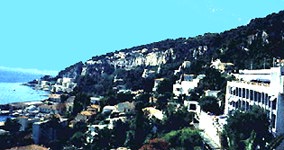

| The Harbour | Le Port |
| Taking a stroll around the harbour
and waterfront of Villefranche-sur-Mer rewards the effort with some suberb
views and a journey through history.
You could start by going through the glacis of the Citadel and along the west ditches which overlook the harbour. (Villefranche is is a deep water harbour which served as a base for the US Sixth Fleet for a time.) Then go to the terreplein of the harbour basin, passing the old rope manufacturers and the old Rochambeau barracks as you go. Move on from the Marine and Zoological Laboratory (which at the time of the Dukes of Savoy was a prison for galley slaves) and you can walk up the rampart and pass under the old watch tower of the former prison to reach the harbour jetty. This is where you will have a fine view over the Raboud Basin, the Port, the Rade and the Citadel. |
Partir du Carrefour de la Libération
(ancien Octroi) sur la BasseCorniche où se trouve le pavillon d'accueill
de l'Office de Tourisme. Emprunter l'avenue de Gaulle, le long du Jardin
Public et du Stade. A gauche, à 100 métres, s'engager sur
les Glacis de la Citadelle en descendant le long des fossés Ouest
d'où l'on domine la Darse.
Gagner le terre-plein du bassin de la Darse en passant devant les bâtiments de l'ancienne Corderie, l'ancienne caserne Rochambeau jusqu'au Domaine du Lazaret. Après avoir dépassé le Laboratoire zoologique et marin (qui fut au temps des Ducs de Savoie le Bagne des Galériens), revenir à gauche par le chemin de ronde qui passe sous l'ancienne tour de guet de cet ancien bagne pour arriver à la jetée de la Darse. De là on domine le Bassin de Radoub, le Port, la Rade et la Citadelle. |
 |
| If you're still in the mood, you could leave
the harbour, passing the Club de Mer (Marine Club) and the gardens, and
walk along the rampart on the waterfront side of the Citadel.
This would take you to Place Wilson with the Harbour-station (where the large cruise ships embark and disembark). The building houses the Customs and the Maritime Affairs Office. Look out for the Club de la Voile (Yacht Club), it's built on the terraces of the old watch tower "La Sante" - and it's not far from the Chapelle Saint-Pierre, the one decorated by Jean Cocteau. The Quai Courbet begins in front of the Hotel Welcome. It's dominated by the high, colourful facades of the houses which once formed the fortified town. The Quai Courbet carries on northwards past a tall house built on the rock. In the 17th century, Charles Quint lived here - this was the time when the "Trêve de Nice" (Truce of Nice) was being drawn up. Further along, you would see the Palais de Marine which dominates the Quai Ponchardier. The Palais was the residence of the Generals of the Duke's Galleys. And it was here that the brother of the commandant of the Savoy's fleet, poet Honore d'Urfé, author of the Astré, passed away. The property now belongs to the town, and is a residential hotel. The Promenade des Marinieres continues along the waterfront giving you the choice of heading towards Cap Ferrat or Beaulieu, depending on which way you turn once you've crossed the Pont Saint Jean. But save that for another day, there's more than enough to occupy you in Villefranche-sur-Mer. |
Quitter la Darse par le Club de la
Mer, les jardins, puis le chemin de ronde qui longe la Citadelle au bord
de la mer. On arrive alors Place Wilson. Là s'élève
la Gare Maritime, où débarquent les passagers des navires
de croisières . Ce bâtiment abrite aussi les locaux de la
Douane, les Affaires maritimes et le siège social du Club de la
Voile s'érige sur les terrasses de l'ancienne tour de guet de la
santé.
Toute proche se dresse fièrement la Chapelle St Pierre, restaurée et decorée par Jean Cocteau. Devant l'Hôtel Welcome commence le pittoresque Quai Courbet que dominent les hautes façades colorées des maisons qui, jadis, formaient la ville fortifiée. Entre les restaurants, la Mère Germaine et 'Le Corsaire' s'ouvre la Porte Robert. Elle mène à la Rue Obscure. Couverte sur plus de la moitié de sa longueur, cette curieuse rue obscure servait autrefois d'abri à la population en cas de bombardement de la cité. Son extrémité Nord rejoint, par un passage étroit, couvert et en pas d'ane la Rue du Poilu (artère principale, infiniment pittoresque, du bourg médiéval). Ce passage se nomme Descente du Conseil . Le Quai Courbet se poursuit vers le Nord en longeant le pied d'une très haute maison bâtie sur un rocher. C'est là qu'habita Charles Quint(au XVIe siècle) pendant les pourparlers de la 'Trêve de Nice'. Plus loin, voici le Palais de la Marine: il domine le Quai Ponchardier. Le Palais était la résidence du Géneral des Galères Ducales. C'est là que mourut le poète Honoré dUrfé, auteur de l'Astrée, frère du commandant de la flotte de Savoie. Propriété de la comune, il abrite maintenant une résidence hôtelière. Revenons à la Chapelle Saint-Pierre et montons la rue de l'Eglise. Comme beaucoup de monuments, l'Eglise Saint Michel date du XV siècle. Elle est de style Jésuite: à gauche de l'autel il y a le tombeau du corsaire sarde Scarampo di Cairo, qui commandait la marine ducale. |

Created, composed, and constructed by vr@i 1995